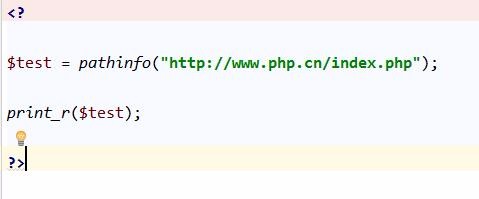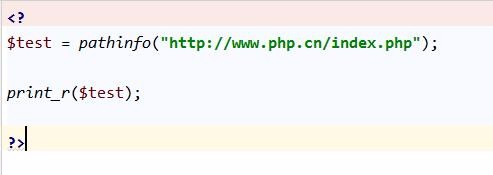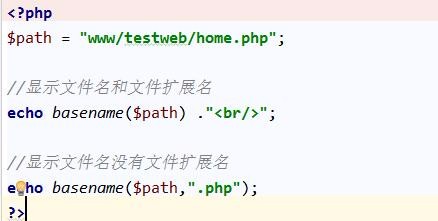10 recommended articles about basename()
The basename() function in PHP gives a string containing the full path to a file. This function returns the basic file name. This article collects several articles about using the PHP basename() function to obtain the file name. This article hopes to help you understand how to use the PHP basename() function to obtain the file name. 1. Detailed explanation of the usage of php basename() function to obtain file name. The php basename() function gives a string containing the full path to a file. This function returns the basic file name. If the filename ends with suffix, this part will also be removed. In Windows, both slash (/) and backslash (\) can be used as directory separators. In other environments, it is a slash (/) 2. Example analysis of __FILE__, dirname and basename usage in PHP This article uses examples to describe the usage of __FILE__, dirname and basename in PHP. Share it with everyone for your reference. The specific method is as follows: __FILE__ the current running file in php
1. Detailed introduction to obtaining the file name

Introduction: The basename() function in PHP gives a string containing the full path to a file. This function returns the basic file name. This article collects There are several articles about using the PHP basename() function to obtain file names. I hope it will be helpful to everyone's understanding of using the PHP basename() function to obtain file names. 1. Detailed explanation of the usage of php basename() function to obtain file name. The php basename() function gives a string containing the full path to a file. This function returns...
2. php Get the file name basename() function usage summary

Introduction: PHP The basename() function gives a string containing the full path to a file. This function returns the basic file name. This article collects several articles about using the PHP basename() function to obtain the file name. I hope it will be helpful to you. It helps to understand that using the PHP basename() function to get the file name is helpful.
3. Explanation on using php pathinfo(), parse_url(), basename() functions to parse URLs

Introduction: PHP functions pathinfo(), parse_url() and basename(), these three are all functions for parsing URLs, but there are some differences. This article Some examples are listed. I hope that these examples will help everyone understand the usage and techniques of these three functions more easily. Let’s take a look:
4. dirname in php , the difference and examples of basename, pathinfo functions

##Introduction: Get the path and directory of the file in php Or file name, we often use the three functions dirname(), basename(), and pathinfo(). These three functions have been introduced in the previous article. This article mainly introduces these three functions to you in detail. Differences and usage examples.
5. Detailed explanation of the php pathinfo() function to obtain the path, name and other information of the file

Introduction: In PHP, it is very easy to obtain the path, name, or extension of a file through functions. You can use dirname(), basename(), pathinfo() and other methods to obtain the corresponding information.
6. Detailed explanation of the usage of php basename() function to obtain the file name

Introduction: We talked about how to use the php pathinfo() function to return the file path information. The php dirname() function returns the directory part of the file path. This article mainly introduces the use of php basename. () function returns the file name part of the path.
7. php uses the functions pathinfo(), parse_url() and basename() to parse the URL_php instance
Introduction: As we all know, functions in PHP pathinfo(), parse_url() and basename(), these three are all functions for parsing URLs, but there are some differences. Some examples are listed below. Through the examples, it is easier to understand the usage and techniques of these three functions. There are Friends who need it can refer to it. Friends who are interested can come and study together.
8. Classic Collection of Commonly Used File Operation Functions in PHP_PHP Tutorial
Introduction: Commonly Used File Operations in PHP Function classic collection. The following is a personal summary of PHP file operation functions. Of course, this is just part of it, there are many more that I didn’t list. 1. Parse the path: 1 Get the file name: basename(); Give a file containing
Introduction: How to get the script name? If my current script is: index.php I want to get the index. How to get it? ------Solution----------- ---------basename(); See the manual ------Solution--------------------$str = "index.php "; $str = strsub($str,0
10. Classic collection of commonly used file operation functions in PHP
##Introduction: The following is a personal collection of commonly used file operation functions in PHP. Summary of PHP file operation functions. Of course, this is only part of it, there are many more, I have not listed them. 1. Get the file name: basename(); Give a file containing
The above is the detailed content of 10 recommended articles about basename(). For more information, please follow other related articles on the PHP Chinese website!

Hot AI Tools

Undresser.AI Undress
AI-powered app for creating realistic nude photos

AI Clothes Remover
Online AI tool for removing clothes from photos.

Undress AI Tool
Undress images for free

Clothoff.io
AI clothes remover

Video Face Swap
Swap faces in any video effortlessly with our completely free AI face swap tool!

Hot Article

Hot Tools

Notepad++7.3.1
Easy-to-use and free code editor

SublimeText3 Chinese version
Chinese version, very easy to use

Zend Studio 13.0.1
Powerful PHP integrated development environment

Dreamweaver CS6
Visual web development tools

SublimeText3 Mac version
God-level code editing software (SublimeText3)

Hot Topics
 1672
1672
 14
14
 1428
1428
 52
52
 1332
1332
 25
25
 1276
1276
 29
29
 1256
1256
 24
24
 Explain secure password hashing in PHP (e.g., password_hash, password_verify). Why not use MD5 or SHA1?
Apr 17, 2025 am 12:06 AM
Explain secure password hashing in PHP (e.g., password_hash, password_verify). Why not use MD5 or SHA1?
Apr 17, 2025 am 12:06 AM
In PHP, password_hash and password_verify functions should be used to implement secure password hashing, and MD5 or SHA1 should not be used. 1) password_hash generates a hash containing salt values to enhance security. 2) Password_verify verify password and ensure security by comparing hash values. 3) MD5 and SHA1 are vulnerable and lack salt values, and are not suitable for modern password security.
 PHP and Python: Comparing Two Popular Programming Languages
Apr 14, 2025 am 12:13 AM
PHP and Python: Comparing Two Popular Programming Languages
Apr 14, 2025 am 12:13 AM
PHP and Python each have their own advantages, and choose according to project requirements. 1.PHP is suitable for web development, especially for rapid development and maintenance of websites. 2. Python is suitable for data science, machine learning and artificial intelligence, with concise syntax and suitable for beginners.
 PHP in Action: Real-World Examples and Applications
Apr 14, 2025 am 12:19 AM
PHP in Action: Real-World Examples and Applications
Apr 14, 2025 am 12:19 AM
PHP is widely used in e-commerce, content management systems and API development. 1) E-commerce: used for shopping cart function and payment processing. 2) Content management system: used for dynamic content generation and user management. 3) API development: used for RESTful API development and API security. Through performance optimization and best practices, the efficiency and maintainability of PHP applications are improved.
 How does PHP type hinting work, including scalar types, return types, union types, and nullable types?
Apr 17, 2025 am 12:25 AM
How does PHP type hinting work, including scalar types, return types, union types, and nullable types?
Apr 17, 2025 am 12:25 AM
PHP type prompts to improve code quality and readability. 1) Scalar type tips: Since PHP7.0, basic data types are allowed to be specified in function parameters, such as int, float, etc. 2) Return type prompt: Ensure the consistency of the function return value type. 3) Union type prompt: Since PHP8.0, multiple types are allowed to be specified in function parameters or return values. 4) Nullable type prompt: Allows to include null values and handle functions that may return null values.
 The Enduring Relevance of PHP: Is It Still Alive?
Apr 14, 2025 am 12:12 AM
The Enduring Relevance of PHP: Is It Still Alive?
Apr 14, 2025 am 12:12 AM
PHP is still dynamic and still occupies an important position in the field of modern programming. 1) PHP's simplicity and powerful community support make it widely used in web development; 2) Its flexibility and stability make it outstanding in handling web forms, database operations and file processing; 3) PHP is constantly evolving and optimizing, suitable for beginners and experienced developers.
 PHP and Python: Different Paradigms Explained
Apr 18, 2025 am 12:26 AM
PHP and Python: Different Paradigms Explained
Apr 18, 2025 am 12:26 AM
PHP is mainly procedural programming, but also supports object-oriented programming (OOP); Python supports a variety of paradigms, including OOP, functional and procedural programming. PHP is suitable for web development, and Python is suitable for a variety of applications such as data analysis and machine learning.
 PHP and Python: Code Examples and Comparison
Apr 15, 2025 am 12:07 AM
PHP and Python: Code Examples and Comparison
Apr 15, 2025 am 12:07 AM
PHP and Python have their own advantages and disadvantages, and the choice depends on project needs and personal preferences. 1.PHP is suitable for rapid development and maintenance of large-scale web applications. 2. Python dominates the field of data science and machine learning.
 How do you prevent SQL Injection in PHP? (Prepared statements, PDO)
Apr 15, 2025 am 12:15 AM
How do you prevent SQL Injection in PHP? (Prepared statements, PDO)
Apr 15, 2025 am 12:15 AM
Using preprocessing statements and PDO in PHP can effectively prevent SQL injection attacks. 1) Use PDO to connect to the database and set the error mode. 2) Create preprocessing statements through the prepare method and pass data using placeholders and execute methods. 3) Process query results and ensure the security and performance of the code.




